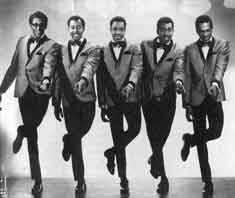To give a brief background on the history behind Motown, it is a record label that was founded by Berry Gordy. It's first locale was Detroit, Michigan in 1960. He was originally a songwriter, but felt that his contribution to music would exponentially increase if he could go into producing and publishing. Motown Records was actually one of two labels that Gordy started. The first was Tamla Records which was founded a year or so before Motown. During the time of its foundation, the United States was going through a lot of racial issues, and was in need of anything and everything that could possibly help bridge the gap between the divide. Motown had many subsidiary labels that covered a wide spectrum of music genres, but their most successful genres were Pop, R&B, Soul, and Hip-Hop. Motown Records was able to overcome racial gaps, by integrating artists into a society using simplistic and straight forward timeless tactics.
Motown Records had a successful production and artist development strategy their focus on changing social aspects had a tremendous impact on the music industry. Motown Records pioneer, Berry Gordy, wanted to cater to African-American artists because he felt that not only was there talent there that could be molded to fit his strategy, he made them his strategy. Instead of the usual: “[let’s] cooperate with an artist who might not have the best musical abilities”, and rather than tweaking his artists to fit the pre-existing standards, he created his own (Wikstorm p. 121). His idea of what genres like Soul, R&B, Pop, and Hip-Hop should be like drove him to accept people for talent instead of a certain image. He wanted to market African-American artists and promote them in a way like none before him. His strategy was to take artists that despite having little to no knowledge of social behavior, or on how to dress for success, he focused on their strong points. He knew they were talented, so why bother trying to create facades out of thin air? Why not take someone with potential, help shape their performance behavior, and let their talent and persona shine through? With the help of great song writers and musicians he took raw talent and leveraged it to build fame. His motive besides the obvious monetary element was to help African-Americans across the globe be recognized as influential artists in genres that stemmed from their own culture. Motown Records used aspects of the artist that were familiar to the entire demographic: gospel was something that was deeply rooted at the time so why not embellish and hone in on something so comfortable to them.
Motown Records was in some cases a pioneering label for African-American music artists. During the early 1960s: not only were these artists trying to be accepted into a predominantly white music market, they were trying to excel. The artist development strategy that Motown Records adapted was geared towards young artists with not much experience. The fact that the label was somewhat of an ambassador for African-American artists forced the Motown artists to carry themselves with class. The label made sure that each of their acts was always groomed properly and that they were dressed well and had their choreography for performances down to a t. The idea behind being groomed so meticulously, was the fact that up and coming artists during this time period were trying to step into a field that, for the longest time, was dominated by white artists. It wasn’t a matter of just appearance for these artists it was more than that, and Motown Records understood. They wanted to develop artists in a way that made them stand out not just through their songs, but in the world itself. Motown had many young artists that weren’t from the best of neighborhoods and as a result, they weren’t that knowledgeable as to how to act dignified or how they should carry themselves (Pomponi). Motown Records allowed these artists not only a platform to pursue a recording career, but a career as a performing artist. The elegance that’s often associated with Motown Record artists is something that the label strived for and achieved quite successfully. There was often a tour every year which allowed the up and coming artists a chance to perform with the stars who had much more experience. The aura that was passed on through the artist development strategy of Motown Records is something that is lacking in artists today. Artists that not only have lewd or explicit conduct in their songs are more often than not presenting the same image out in the world. What is worse about this lack of elegance in artists today is that they’re tarnishing the genre as a whole. They’re so focused on paying strict attention to the hit factor they forget that they’re being criticized in other dimensions: something Motown Records made sure to instill in their artists.
Motown Records was started during a time of great racial strides. African-Americans were not only just starting to receive equal rights but for the first time they were starting to create a significant impact in the music industry. With the help of Motown Records, Motown Sound was instilled in every artist under the label (Emmerson). Motown Sound was a very successful production approach that the company used in order to produce a string of hits such as “What’s Going On” by Marvin Gaye, “Ain’t Too Proud to Beg” by the Temptations just to name a couple. The idea behind Motown Sound was to create songs with Pop appeal; they often had a lot of things that accented back beats or the back drop. The idea was to keep everything simple. There was no need to create complex vocal or musical arrangements, because that was just deter from the actual talent behind the song itself. Motown Sound was a strategy that not only bred successful legends such as Marvin Gaye, The Supremes, The Temptations, Smokey Robinson, etc. it was influential on a larger scale as well:


Motown Sound was a simple yet effective strategy in terms of setting Motown artists apart from others. The rationale behind the “KISS” (keep it simple, stupid) principle is something that was not taken lightly (Justman). Once other people caught wind of Motown Sound and the business idea behind setting themselves apart through simplistic song, they flocked to Detroit: "They figured it was in the air, that if they came to Detroit and recorded on the freeway, they'd get the Motown sound. Listen, the Motown sound to me is not an audible sound. It's spiritual, and it comes from the people that make it happen” (Hirshey). The classic simplicity of Motown songs surpassed their competition, and not only helped them to achieve new heights but paved way for popular artist development trends as well.
Motown Records was in some cases a pioneering label for African-American music artists. During the early 1960s: not only were these artists trying to be accepted into a predominantly white music market, they were trying to excel. The artist development strategy that Motown Records adapted was geared towards young artists with not much experience. The fact that the label was somewhat of an ambassador for African-American artists forced the Motown artists to carry themselves with class. The label made sure that each of their acts was always groomed properly and that they were dressed well and had their choreography for performances down to a t. The idea behind being groomed so meticulously, was the fact that up and coming artists during this time period were trying to step into a field that, for the longest time, was dominated by white artists. It wasn’t a matter of just appearance for these artists it was more than that, and Motown Records understood. They wanted to develop artists in a way that made them stand out not just through their songs, but in the world itself. Motown had many young artists that weren’t from the best of neighborhoods and as a result, they weren’t that knowledgeable as to how to act dignified or how they should carry themselves (Pomponi). Motown Records allowed these artists not only a platform to pursue a recording career, but a career as a performing artist. The elegance that’s often associated with Motown Record artists is something that the label strived for and achieved quite successfully. There was often a tour every year which allowed the up and coming artists a chance to perform with the stars who had much more experience. The aura that was passed on through the artist development strategy of Motown Records is something that is lacking in artists today. Artists that not only have lewd or explicit conduct in their songs are more often than not presenting the same image out in the world. What is worse about this lack of elegance in artists today is that they’re tarnishing the genre as a whole. They’re so focused on paying strict attention to the hit factor they forget that they’re being criticized in other dimensions: something Motown Records made sure to instill in their artists.
This definitely brings up the issue of sampling in popular music today. There are many stars that sample old school hits because they're not only away of how successful they are, but the emotions they stir up. Take Kanye and Jay-Z's "Otis" for example. It's not only one of the most successful songs off their recently released Watch The Throne album, but listeners young and old can't help but be drawn to the soul that's evoked by the sample. The original is a sound that's hard to come by these days, and rather than imitate it, why not pay tribute by letting people hear the real thing.
Of course they had to put their own spin on it to make it somewhat unrecognizable, but there is no denying that artists today, although few, understand the importance of soulful music.
Although Motown Records had a successful production and artist development strategy their focus on changing social aspects had a tremendous impact on the music industry. Motown Records pioneer, Berry Gordy, wanted to cater to African-American artists because he felt that not only was there talent there that could be molded to fit his strategy, he made them his strategy. Instead of the usual: “[let’s] cooperate with an artist who might not have the best musical abilities”, and rather than tweaking his artists to fit the pre-existing standards, he created his own (Wikstorm p. 121). His idea of what genres like Soul, R&B, Pop, and Hip-Hop should be like drove him to accept people for talent instead of a certain image. He wanted to market African-American artists and promote them in a way like none before him. His strategy was to take artists that despite having little to no knowledge of social behavior, or on how to dress for success, he focused on their strong points. He knew they were talented, so why bother trying to create facades out of thin air? Why not take someone with potential, help shape their performance behavior, and let their talent and persona shine through? With the help of great song writers and musicians he took raw talent and leveraged it to build fame. His motive besides the obvious monetary element was to help African-Americans across the globe be recognized as influential artists in genres that stemmed from their own culture. Motown Records used aspects of the artist that were familiar to the entire demographic: gospel was something that was deeply rooted at the time so why not embellish and hone in on something so comfortable to them. Speaking of artists that had strong gospel roots, there's no leaving out the Jackson 5.
The Jackson 5, were just one of the many successful groups, but in my opinion they were the most successful. They not only stuck to their roots, but were very aware of how important showmanship was along with their image.
Motown Records even took on a new and important strategy of trying to diversify their production companies. The company eventually expanded into Motown Industries and Motown Productions which helped fulfill other strategies implemented by the label of television and publishing. Berry Gordy wanted his artists to not only be seen locally but nationally as well. He wanted to promote his artists on television specials as well as in motion pictures. He was successful in creating two films ‘Lady Sings the Blues’ and ‘Mahogany’ and set the tone for future recording label to follow his lead in creating movies that featured artists they managed. If artists were successful why did their career have to stop just at the recording level? Why not turn your artists iconic and set the bar higher for a whole group of people while you’re at it! He took what he knew his artists were good at and gave them a place to prosper with his guidance: “the ability for amateurs to express their creativity” (Wikstrom p. 118).
Although Motown eventually was sold during the late 1980s, the ideals and strategies still live on. Motown Records was eventually changed to Universal Motown which is under the Universal Music Group umbrella. The idea to promote the once famous songs recorded on vinyl and transfer them to CD was one that isn’t new nowadays, but one that is still successful. Universal Motown took most of their popular Billboard #1 hits and created CDs to help further the promotion of feel good music. As of late, Universal Motown has reverted back to its roots and is under The Island Def Jam Motown Music Group (Universal). This not only tells up and coming labels that Motown Records has iconic artists under their belt, but that they’re doing something right. Their strategy of really honing in on the artists’ talent instead of trying to cover up a lack thereof is the best if not only strategy that labels should be focusing on. Some labels today are so obsessed with trying to find the hit on the demo that they don't stop to actually listen to the artist. Yes appearance matters, but at what cost if no one wants to hear what they have to sing? Motown's simplistic approach to scouting talent is one that often overlooked as a strategy that works. If it's not broke, why fix it?
Works Cited
Emmerson, Kassidy. “History of Motown Records: Berry Gordon and Rhythm and Blues Music." Associated Content Feb. 2006:Associated Content. Web. 13 Oct. 2011.
<http://www.associatedcontent.com/article/17936/historyofmotownrecordlabel_berry.html?cat=33 >.
Hirshey, Gerri (1994 [1984]). Nowhere to Run: The Story of Soul Music. New York: Da Capo Press. p. 187. ISBN 0-306-80581-2.
Justman, Paul. (2002). Standing in the Shadows of Motown. [DVD]. Santa Monica, California: Artisan Entertainment.
Pomoni, Christina. "The History of Motown Records." Associated Content Sept. 2009: Associated Content. Web. 13 Oct. 2011. <http://www.associatedcontent.com/article/17936/historyofmotownrecordlabel_berry.html?cat=33>.
“Universal Music Group (UMG) Promotes Ethiopia Habtemariam to Senior Vice President of Motown Records” NEW YORK, Aug. 10, 2011 /PRNewswire/
Wikstrom, Patrik. The Music Industry. Malden, MA: Polity Press, 2009. Print.









